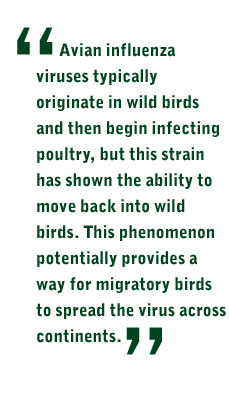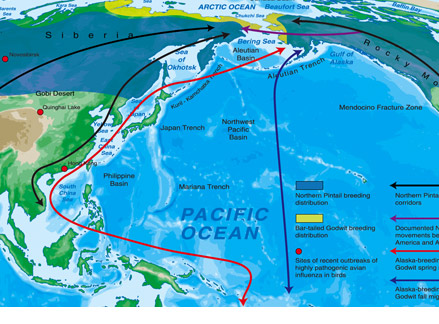


Averting the Next Pandemic
by Sam Fahmy
Intro
|
What's a Danger, And What's Not
|
Staying Ahead Of The Threat
|
Taking A Broad Perspective

![]()

Taking A Broader Perspective
Stallknecht has just begun work on a planned three-year grant, totaling $2.6 million, from the CDC to investigate the possibility of human contact with avian influenza viruses. He will draw on the expertise of researchers across campus, at Southeast Poultry and at other federal and state agencies.
In the first part of the study, Stallknecht, doctoral student Dr. Justin Brown, and colleagues at Southeast Poultry will examine how long avian influenza viruses remain infectious in water. With the help of Lisa Stewart at the U.S. Geological Survey’s Water Science Center, the researchers will explore how factors such as temperature, pH and salt concentration influence viral persistence.
Next, Dana Cole at the Georgia Department of Public Health, Steve Valeika at the UGA College of Public Health and Pej Rohani at the Institute of Ecology will work with the researchers to assess the probability of human contact with the viruses. For example, are duck hunters at risk? How about swimmers?

Migratory routes of two species illustrate the movements of birds between Asia and North America. Click on the map for a larger view.
Erin Lipp at UGA’s Department of Environmental Health Science will examine whether filter feeders such as clams and mussels have the potential to concentrate the viruses and sicken those who eat them. On the other hand, it’s possible that the filter feeders may reduce the likelihood of transmission by removing the viruses from the water. Maricarmen Garcia and Mark Jackwood at the UGA Poultry and Diagnostic Research Center will examine the risk to poultry workers and the persistence of the viruses on surfaces such as poultry litter.
Finally, the team will collaborate with Mark Tompkins at UGA’s Department of Infectious Diseases and Elizabeth Howerth at the Department of Pathology (both in UGA’s College of Veterinary Medicine) to assess the ability of low-pathogenic avian influenza viruses to infect mammals. In that way, the potential risk to humans may be better understood.
“To prevent the next pandemic, we really need to understand how these viruses operate,” Stallknecht said. “So it really calls for a broad perspective.”
The 1983 outbreak that gave him his start in avian influenza research cost the federal government $63 million, and consumers paid an extra $350 million in higher poultry prices. Seventeen million birds died or were culled as a result of the outbreak. Still, Stallknecht points out that the virus responsible for the outbreak was effectively eradicated in two years.
Worldwide, the Asian H5N1 strain has already caused more damage and persisted longer than the virus that caused the Pennsylvania outbreak. But the researchers hope that their work will uncover simple preventive measures that can keep poultry, wild birds and people healthy.
“By studying these viruses and by looking at the interface between wildlife, domestic poultry and agriculture, we can hope to prevent what’s happened in Asia from happening here,” Swayne said.
For more information contact David Stallknecht at dstall@vet.uga.edu or David Swayne at dswayne@seprl.usda.gov.
Intro
|
What's a Danger, And What's Not
|
Staying Ahead Of The Threat
|
Taking A Broad Perspective
For comments or for information please e-mail: rcomm@uga.edu
To contact the webmaster please email: ovprweb@uga.edu
![]()